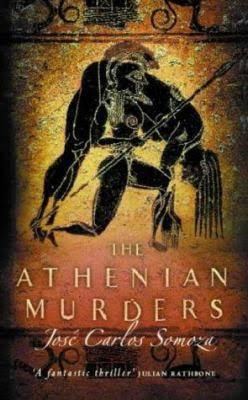7.6 /10 1 Votes7.6
Country Spain Publisher Abacus Published in English 2002 | 3.8/5 Goodreads Language Spanish Publication date 2000 Originally published 2000 Published in english 2002 | |||||||||||||||||||||||||||||||||
 | ||||||||||||||||||||||||||||||||||
Original title La caverna de las ideas Nominations CWA Ellis Peters Historical Dagger Award Similar José Carlos Somoza books, Mystery books, Police books | ||||||||||||||||||||||||||||||||||
The Athenian Murders is an historical mystery novel written by Spanish author José Carlos Somoza. Originally published in Spain under the title La caverna de las ideas (The Cave of Ideas) in 2000, it was translated into English in 2002 by Sonia Soto. The Athenian Murders is Somoza's first novel to be published in English. It won the 2002 Gold Dagger Award.
Contents
Plot summary
The book is presented as a translation of an ancient Greek novel published in Athens just after the Peloponnesian War, complete with the extensive footnotes from the scholar performing the translation. In the ancient novel (which is itself called The Athenian Murders), a young ephebe named Tramachus is discovered on the slopes of Mount Lycabettus, apparently attacked by wolves. Diagoras, the boy's erastes and tutor at the Academy, enlists the help of a "Decipherer of Enigmas" (a detective named Heracles Pontor) to learn more about Tramachus's death. As Diagoras and Heracles investigate, more youths from the Academy are discovered brutally murdered. Their investigation takes them all over Athens, from mystery cult worship services to a symposium hosted by Plato.
Meanwhile, the translator (who is never named) provides frequent commentary on the work, particularly as he believes it to be an example of a (fictional) ancient literary device called eidesis. "Eidesis" is the practice of repeating words or phrases so as to evoke a particular image or idea in the reader's mind, as if it were a kind of literary steganography. As the translator works on the novel, he concludes that the eidetic secret concealed within the novel is The Twelve Labors of Heracles, one labor for each of the twelve chapters of the novel. The translator becomes obsessed with the imagery, going so far as to see himself depicted within the ancient work.
Partway through the novel, the translator is kidnapped and forced to continue the translation in a cell. His captor turns out to be the scholar Montalo, whose edition of The Athenian Murders is the only surviving copy of the work. Montalo himself had obsessed over the novel, hoping to find in it a proof of Plato's Theory of Forms. He felt that should an eidetic text, such as this novel, evoke the same ideas in each reader it would then prove that ideas have a separate, independent reality. However, Montalo finished the translation only to discover that the book proved the opposite—that the book proved his (and the translator's) reality did not exist. The translator finishes the work only to have the same realization: that they themselves are characters in The Athenian Murders, which was written by a colleague of Plato named Philotextus as a way to incorporate Plato's theory of knowledge while criticizing the philosophical lifestyle.
